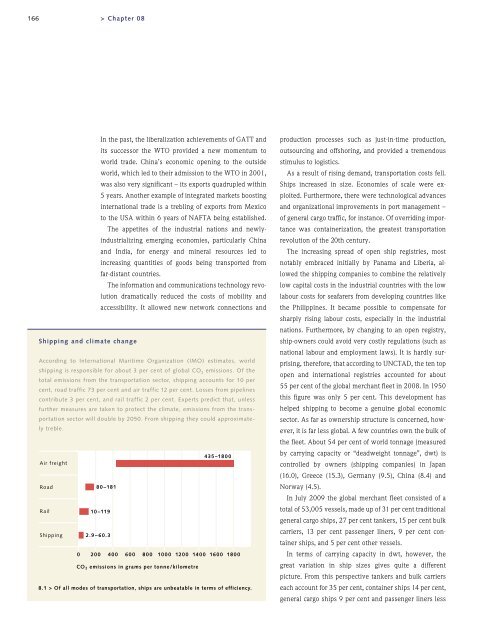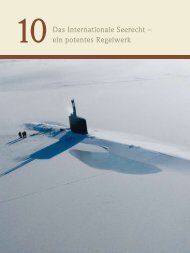Maritime highways of global trade - World Ocean Review
Maritime highways of global trade - World Ocean Review
Maritime highways of global trade - World Ocean Review
Create successful ePaper yourself
Turn your PDF publications into a flip-book with our unique Google optimized e-Paper software.
166<br />
> Chapter 08<br />
Shipping and climate change<br />
In the past, the liberalization achievements <strong>of</strong> GATT and<br />
its successor the WTO provided a new momentum to<br />
world <strong>trade</strong>. China’s economic opening to the outside<br />
world, which led to their admission to the WTO in 2001,<br />
was also very significant – its exports quadrupled within<br />
5 years. Another example <strong>of</strong> integrated markets boosting<br />
international <strong>trade</strong> is a trebling <strong>of</strong> exports from Mexico<br />
to the USA within 6 years <strong>of</strong> NAFTA being established.<br />
The appetites <strong>of</strong> the industrial nations and newlyindustrializing<br />
emerging economies, particularly China<br />
and India, for energy and mineral resources led to<br />
increasing quantities <strong>of</strong> goods being transported from<br />
far-distant countries.<br />
The information and communications technology revolution<br />
dramatically reduced the costs <strong>of</strong> mobility and<br />
accessibility. It allowed new network connections and<br />
According to International <strong>Maritime</strong> Organization (IMO) estimates, world<br />
shipping is responsible for about 3 per cent <strong>of</strong> <strong>global</strong> CO2 emissions. Of the<br />
total emissions from the transportation sector, shipping accounts for 10 per<br />
cent, road traffic 73 per cent and air traffic 12 per cent. Losses from pipelines<br />
contribute 3 per cent, and rail traffic 2 per cent. Experts predict that, unless<br />
further measures are taken to protect the climate, emissions from the transportation<br />
sector will double by 2050. From shipping they could approximately<br />
treble.<br />
Air freight<br />
Road<br />
Rail<br />
Shipping<br />
80–181<br />
10–119<br />
2.9–60.3<br />
0 200 400 600 800 1000 1200 1400 1600 1800<br />
CO2 emissions in grams per tonne/kilometre<br />
435–1800<br />
8.1 > Of all modes <strong>of</strong> transportation, ships are unbeatable in terms <strong>of</strong> efficiency.<br />
production processes such as just-in-time production,<br />
outsourcing and <strong>of</strong>fshoring, and provided a tremendous<br />
stimulus to logistics.<br />
As a result <strong>of</strong> rising demand, transportation costs fell.<br />
Ships increased in size. Economies <strong>of</strong> scale were exploited.<br />
Furthermore, there were technological advances<br />
and organizational improvements in port management –<br />
<strong>of</strong> general cargo traffic, for instance. Of overriding importance<br />
was containerization, the greatest transportation<br />
revolution <strong>of</strong> the 20th century.<br />
The increasing spread <strong>of</strong> open ship registries, most<br />
notably embraced initially by Panama and Liberia, allowed<br />
the shipping companies to combine the relatively<br />
low capital costs in the industrial countries with the low<br />
labour costs for seafarers from developing countries like<br />
the Philippines. It became possible to compensate for<br />
sharply rising labour costs, especially in the industrial<br />
nations. Furthermore, by changing to an open registry,<br />
ship-owners could avoid very costly regulations (such as<br />
national labour and employment laws). It is hardly surprising,<br />
therefore, that according to UNCTAD, the ten top<br />
open and international registries accounted for about<br />
55 per cent <strong>of</strong> the <strong>global</strong> merchant fleet in 2008. In 1950<br />
this figure was only 5 per cent. This development has<br />
helped shipping to become a genuine <strong>global</strong> economic<br />
sector. As far as ownership structure is concerned, however,<br />
it is far less <strong>global</strong>. A few countries own the bulk <strong>of</strong><br />
the fleet. About 54 per cent <strong>of</strong> world tonnage (measured<br />
by carrying capacity or “deadweight tonnage”, dwt) is<br />
controlled by owners (shipping companies) in Japan<br />
(16.0), Greece (15.3), Germany (9.5), China (8.4) and<br />
Norway (4.5).<br />
In July 2009 the <strong>global</strong> merchant fleet consisted <strong>of</strong> a<br />
total <strong>of</strong> 53,005 vessels, made up <strong>of</strong> 31 per cent traditional<br />
general cargo ships, 27 per cent tankers, 15 per cent bulk<br />
carriers, 13 per cent passenger liners, 9 per cent container<br />
ships, and 5 per cent other vessels.<br />
In terms <strong>of</strong> carrying capacity in dwt, however, the<br />
great variation in ship sizes gives quite a different<br />
picture. From this perspective tankers and bulk carriers<br />
each account for 35 per cent, container ships 14 per cent,<br />
general cargo ships 9 per cent and passenger liners less
















